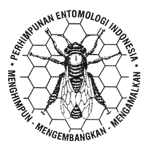Biologi ngengat Galleria mellonella (Linn.) (Lepidoptera: Pyralidae) pada beberapa jenis pakan buatan
DOI:
https://doi.org/10.5994/jei.19.3.243Keywords:
fecundity, fertility, life cycleAbstract
The greater wax moth (Galleria mellonella (Linnaeus)) is one of Asia's most essential pests in honey beekeeping. Apart from being a pest, G. mellonella was also used as a test insect in several business fields. The needs of the population of G. mellonella encourage several areas of the business to cultivate it practically and economically. This study aimed to determine and examine the composition of food ingredients as an artificial diet that can affect the growth and development of G. mellonella. The test consisted of four different feed-modified formulas, namely P1 (corn flour, wheat, glycerol, and yeast), P2 (rice flour, wheat flour, wheat bran, glycerol, and yeast), P3 (wheat flour, wheat, glycerol, and yeast), and P4 (brown rice, glycerol, and yeast). The observation criteria were life cycle, mortality rate, fecundity, and egg fertility of the G. mellonella moth. Based on the study's results, the life cycle development of G. mellonella was the shortest in the P3 treatment (71.5 ± 5.2 days) and the longest P4 treatment (84.2 ± 8.3 days). The highest mortality rate was in the P3 feed type at 13.12%, while the lowest occurred in the P4 treatment at 4.44%. Based on the fecundity of female imago, treatment P4 had the highest fecundity level of 527.7 eggs/female, while treatment P1 was the lowest (169.6 eggs/female). P4 treatment responded best to several biological aspects of the G. mellonella moth, such as larger body size, lower mortality, and high fecundity rates.
Downloads
Downloads
Published
How to Cite
Issue
Section
License
Copyright (c) 2022 Nadzirum Mubin, Mohammad Riza Krisnadi, Teguh Santoso, Fitrianingrum Kurniawati

This work is licensed under a Creative Commons Attribution 4.0 International License.
Authors who publish with this journal agree to the following terms:
- Authors retain copyright and grant the journal right of first publication with the work simultaneously licensed under a Creative Commons Attribution 4.0 International License that allows others to share the work with an acknowledgement of the work's authorship and initial publication in this journal.
- Authors are able to enter into separate, additional contractual arrangements for the non-exclusive distribution of the journal's published version of the work (e.g., post it to an institutional repository or publish it in a book), with an acknowledgement of its initial publication in this journal.
- Authors are permitted and encouraged to post their work online (e.g., in institutional repositories or on their website) prior to and during the submission process, as it can lead to productive exchanges, as well as earlier and greater citation of published work (See The Effect of Open Access).








